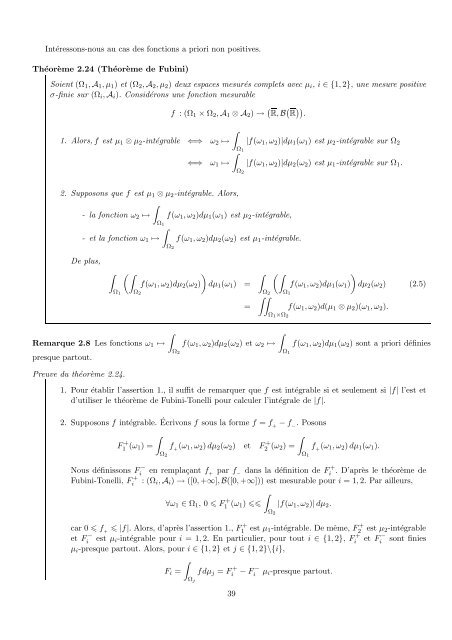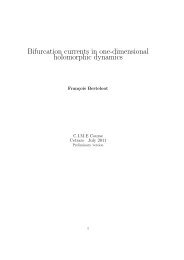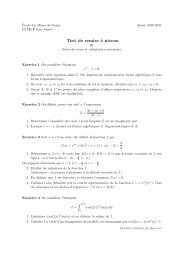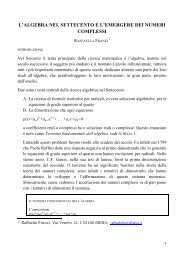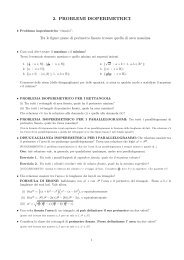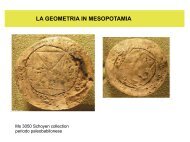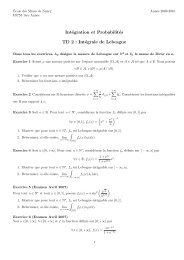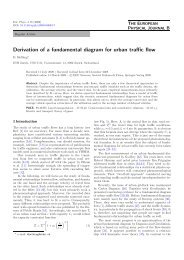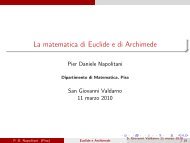Alors, A ∈ A <strong>et</strong> A c ∈ A car les fonctions f n <strong>et</strong> g sont mesurables, B ∈ A <strong>et</strong> A est une tribu. De plus,0 µ(A c ) µ(B c ) + µ({g = +∞}) ++∞∑n=0µ({|f n | > g}) = 0d’après l’assertion 3. de la proposition 1.19 page 11. Par conséquent, µ(A c ) = 0 <strong>et</strong> donc A c est un ensembleµ-négligeable. Alors, par définition de A, |f| g µ-presque partout. Par suite, d’après la proposition 2.18,la fonction f est µ-intégrable car g l’est.Pour tout n ∈ N, considérons à présent l’application mesurable g n = 2g − |f n − f|1 A . Alors,∫ ∫ ∫∫ ∫g n dµ = 2 g dµ − 1 A |f n − f|dµ = 2 g dµ − |f n − f|dµ.ΩPar ailleurs, limn→+∞ g n = 2g. Alors, d’après le lemme de Fatou,∫2 g dµ lim infΩn→+∞ΩΩ( ∫ ∫ ) ∫2 g dµ − |f n − f|dµ = 2Ω ΩΩΩΩ∫g dµ − lim sup |f n − f|dµ.n→+∞ ΩPar conséquent,∫<strong>et</strong> donc lim |f n − f|dµ = 0. Remarquons quen→+∞Ω∣∫∣∀n ∈ N,∣Ω∫f n dµ −Ω∫0 = lim sup |f n − f|dµn→+∞ Ω∣∫∣∣∣f dµ∣ =∫Alors, en faisant tendre n → +∞, nous obtenons :ΩΩ∫(f n − f) dµ∣ ∫f dµ = limn→+∞ΩΩ|f n − f|dµ,f n dµ.2.4 Théorème de FubiniL’intégrale d’une fonction f par rapport à une mesure produit µ 1 ⊗µ 2 , lorsqu’elle a un sens, se ramène ≪ engénéral ≫ au calcul d’intégrales par rapport à µ 1 <strong>et</strong> µ 2 . Étudions tout d’abord le cas des fonctions mesurablesà valeurs dans [0,+∞].Théorème 2.23 (Théorème de Fubini-Tonelli)Soient (Ω 1 , A 1 ,µ 1 ) <strong>et</strong> (Ω 2 , A 2 ,µ 2 ) deux espaces mesurés. Pour tout i ∈ {1,2}, supposons que µ i est unemesure positive σ-finie sur (Ω i , A i ). Soitf : (Ω 1 × Ω 2 , A 1 ⊗ A 2 ) → ([0,+∞], B([0,+∞]))une fonction mesurable à valeurs dans [0,+∞]. Nous considérons∫∫F 1 (ω 1 ) = f(ω 1 ,ω 2 )dµ 2 (ω 2 ) <strong>et</strong> F 2 (ω 2 ) = f(ω 1 ,ω 2 )dµ 1 (ω 1 ).Ω 2 Ω 1Alors pour i ∈ {1,2}, la fonction F i : (Ω i , A i ) → ([0,+∞], B([0,+∞])) est mesurable. De plus∫∫∫∫F 1 (ω 1 )dµ 1 (ω 1 ) = F 2 (ω 2 )dµ 2 (ω 2 ) = f(ω 1 ,ω 2 )d(µ 1 ⊗ µ 2 )(ω 1 ,ω 2 ).Ω 1 Ω 2 Ω 1 ×Ω 238
Intéressons-nous au cas des fonctions a priori non positives.Théorème 2.24 (Théorème de Fubini)Soient (Ω 1 , A 1 ,µ 1 ) <strong>et</strong> (Ω 2 , A 2 ,µ 2 ) deux espaces mesurés compl<strong>et</strong>s avec µ i , i ∈ {1,2}, une mesure positiveσ-finie sur (Ω i , A i ). Considérons une fonction mesurablef : (Ω 1 × Ω 2 , A 1 ⊗ A 2 ) → ( R, B ( R )) .∫1. Alors, f est µ 1 ⊗ µ 2 -intégrable ⇐⇒ ω 2 ↦→ |f(ω 1 ,ω 2 )|dµ 1 (ω 1 ) est µ 2 -intégrable sur Ω 2Ω∫ 1⇐⇒ ω 1 ↦→ |f(ω 1 ,ω 2 )|dµ 2 (ω 2 ) est µ 1 -intégrable sur Ω 1 .Ω 22. Supposons que f est µ 1 ⊗ µ 2 -intégrable. Alors,∫- la fonction ω 2 ↦→ f(ω 1 ,ω 2 )dµ 1 (ω 1 ) est µ 2 -intégrable,Ω 1∫- <strong>et</strong> la fonction ω 1 ↦→ f(ω 1 ,ω 2 )dµ 2 (ω 2 ) est µ 1 -intégrable.Ω 2De plus,∫Ω 1(∫)f(ω 1 ,ω 2 )dµ 2 (ω 2 ) dµ 1 (ω 1 ) =Ω 2=∫Ω 2(∫∫∫)f(ω 1 ,ω 2 )dµ 1 (ω 1 )Ω 1dµ 2 (ω 2 ) (2.5)Ω 1 ×Ω 2f(ω 1 ,ω 2 )d(µ 1 ⊗ µ 2 )(ω 1 ,ω 2 ).∫∫Remarque 2.8 Les fonctions ω 1 ↦→presque partout.f(ω 1 ,ω 2 )dµ 2 (ω 2 ) <strong>et</strong> ω 2 ↦→Ω 2f(ω 1 ,ω 2 )dµ 1 (ω 2 ) sont a priori définiesΩ 1Preuve du théorème 2.24.1. Pour établir l’assertion 1., il suffit de remarquer que f est intégrable si <strong>et</strong> seulement si |f| l’est <strong>et</strong>d’utiliser le théorème de Fubini-Tonelli pour calculer l’intégrale de |f|.2. Supposons f intégrable. Écrivons f sous la forme f = f − f . Posons+ −F 1 + (ω 1) =∫f +(ω 1 ,ω 2 )dµ 2 (ω 2 ) <strong>et</strong>Ω 2F 2 + (ω 2) =∫f +(ω 1 ,ω 2 )dµ 1 (ω 1 ).Ω 1Nous définissons Fi − en remplaçant f +par f −dans la définition de Fi + . D’après le théorème deFubini-Tonelli, Fi+ : (Ω i , A i ) → ([0,+∞], B([0,+∞])) est mesurable pour i = 1,2. Par ailleurs,∫∀ω 1 ∈ Ω 1 , 0 F 1 + (ω 1) |f(ω 1 ,ω 2 )|dµ 2 .Ω 2car 0 f + |f|. Alors, d’après l’assertion 1., F 1 + est µ 1-intégrable. De même, F 2 + est µ 2-intégrable<strong>et</strong> Fi − est µ i -intégrable pour i = 1,2. En particulier, pour tout i ∈ {1,2}, Fi+ <strong>et</strong> Fi− sont finiesµ i -presque partout. Alors, pour i ∈ {1,2} <strong>et</strong> j ∈ {1,2}\{i},∫F i = fdµ j = Fi+ − Fi− µ i -presque partout.Ω j39
- Page 1: Année 2009-2010Intégration et Pro
- Page 6 and 7: Remarque 1.1 En probabilités, un e
- Page 8 and 9: Remarque 1.3 Une tribu étant stabl
- Page 10 and 11: Exemple 1.4 Soient (Ω, A) un espac
- Page 12 and 13: Preuve de la proposition 1.15. Éta
- Page 14 and 15: Donnons à présent la mesure d’u
- Page 16 and 17: 1.3.2 Un exemple : les fonctions é
- Page 18 and 19: Preuve de la proposition 1.29.• S
- Page 20 and 21: Remarque 1.21 Soit (Ω, A,µ) un es
- Page 22 and 23: 1. Montrons que µ est bien défini
- Page 24 and 25: • Supposons I fini. Nous pouvons
- Page 26 and 27: D’après (i), (ii), (iii) et (iv)
- Page 28 and 29: Exemple 2.1∫1. Supposons que µ =
- Page 30 and 31: Nous pouvons donc considérer une s
- Page 32 and 33: 2.1.3 Intégrale d’une fonction d
- Page 34 and 35: 2.2 Propriétés générales de l
- Page 36 and 37: Nous pouvons énoncer une propriét
- Page 38 and 39: • Étant donné que pour tout n
- Page 42 and 43: Nous pouvons prolonger F i en une f
- Page 44 and 45: Proposition 2.27 (Riemann-intégrab
- Page 46 and 47: 2.5.3 L’essentiel de la section 2
- Page 48 and 49: • Fixons n ∈ N. Notons que par
- Page 51 and 52: Chapitre 3Loi d’une variable alé
- Page 53 and 54: 3.2 Mesure image et loi d’une var
- Page 55 and 56: De plus, (ϕ n ◦ X) n∈N est une
- Page 57 and 58: 2. Par ailleurs, pour tous réels a
- Page 59 and 60: Preuve de la proposition 3.13. Nous
- Page 61 and 62: ••2. Soit F : R → R une fonct
- Page 63 and 64: 3.4 Variables aléatoires et lois a
- Page 65 and 66: La fonction borélienne f étant po
- Page 67 and 68: 3.4.3 Changement de variablesNous n
- Page 69 and 70: Proposition 3.33 (Fonction de répa
- Page 71 and 72: Proposition 3.38Soient X une variab
- Page 73 and 74: Nous commençons par étudier le ca
- Page 75 and 76: Chapitre 4Espaces L p et L pDans ce
- Page 77 and 78: Définition 4.3 (Espace L ∞ (Ω,
- Page 79 and 80: Terminons cette section en remarqua
- Page 81 and 82: Dans le cas où µ est une mesure b
- Page 83 and 84: Par suite,‖f + g‖ p p (‖f‖
- Page 85 and 86: Cette propriété est une conséque
- Page 87 and 88: 4.3 Espaces L p et L p sur un espac
- Page 89 and 90: 4.3.2 InégalitésCommençons par r
- Page 91 and 92:
4.4 Annexes4.4.1 Annexe : Preuve du
- Page 93 and 94:
Étudions à présent les moments d
- Page 95 and 96:
Annexe AClasses monotonesDe nombreu
- Page 97 and 98:
Ce théorème permet de montrer que
- Page 99 and 100:
Annexe BIntégrales dépendant d’
- Page 101 and 102:
Loi de la v.a. X P X Espérance Var
- Page 103:
Bibliographie[1] Barbe, P. et Ledou


